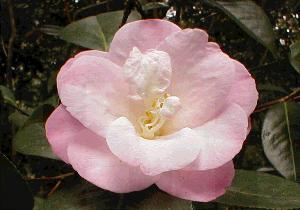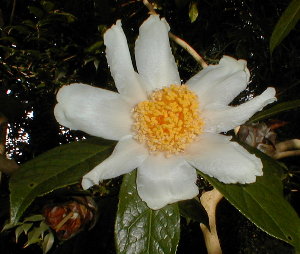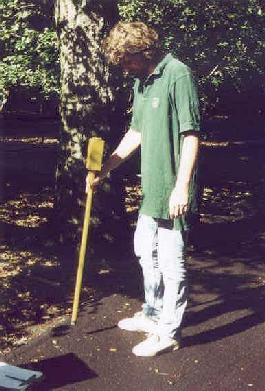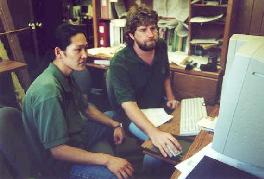BG-Map Feature
Article
|
Descanso Gardens |
|
|
|
|
Descanso
Gardens, a 150-acre display garden in La CaŮada Flintridge, California, is
the former estate of local newspaper publisher E. Manchester Boddy. Boddy
purchased the then "Rancho del Descanso" in 1936. He envisioned the
site as a working landscape, and operated a cut flower camellia plantation, a
commercial nursery, and, briefly, a public garden. At the same time, it was
Boddy's "ranch home", complete with cow pasture, chicken coop,
hunting ground, fishing hole, orchard, vegetable and pleasure gardens. Boddy sold the land to
the County of Los Angeles late in 1953. The County still owns the land. The
non-profit Descanso Gardens Guild has managed the grounds under contract
since 1993. |
|
|
The 60 acres that are landscaped and open to the public Boddy initiated three of
these collections - camellias, lilacs and roses. |
|
Boddy began planting
camellias soon after purchasing the land. He concentrated on the japonica
cultivars popular as corsages. After a slow start, the largest single
development of the collection came in 1942, when Boddy purchased the entire
stock of a nursery whose Japanese-American owner was being sent to the World
War II internment camps. Descanso Gardens received some 100,000 these
camellias. They included a mix of the owner's personal collection of Japanese
introductions, seedlings under evaluation, and the important Camellia
japonica cultivars of the day. Boddy introduced to the trade some plants
from this purchase, including the seedling Camellia japonica 'Berenice
Boddy', named for his wife. Even though Boddy removed half of the plants when
he sold the land to Los Angeles County, this single purchase remains the
foundation of the collection today. The next major
development in the camellia collection came in 1948. Descanso Gardens was the
first facility in a century to import cultivars of the very large flowered Camellia
reticulata from the Yunnan province of China. Fifteen of the 20 imported
cultivars were successfully established. Virtually all reticulata cultivars
and hybrids available in the West today trace their lineage to these
introductions. The following year a
hybridization program was initiated. Several breeding objectives were set out
including expansion of the bloom season, color palette, increased bloom
intensity, cold hardy flowers, and maintaining the flower size of Camellia
reticulata on a more compact plant. This program led to the establishment
of a camellia species collection. This collection is currently being
refurbished in cooperation with other institutions. Descanso currently boasts
the largest camellia species collection in North America. |
Camellia Japonica 'Berenice Boddy' The public garden era at
Descanso Gardens has produced the most taxa in the collection. New cultivars
primarily of Camellia japonica were introduced from nurseries in the
southeastern US in the early and mid 1950s. And a generous donation in the
early 1960s enabled the garden to purchase new introductions for the period
of roughly 1962-1967.
Camellia granthamiana The last three years have
been another period of active collection development. Descanso Gardens
declared 1997 the "Year of the Camellia Forest." This garden-wide
effort created staffing specifically for the Camellia Forest and led to the
botanical and horticultural rejuvenation of the collection. This in turn has
led to updating the collection with emphasis on camellia species,
reticulatas, saluenensis hybrids, award winning miniatures and other new
introductions. The "Year of the Camellia Forest" also allowed the
garden to begin the process of organizing this complex collection into a
series of orderly sub-collections. |
|
|
|
|
The "International Rosarium", home of our rose and iris
collections, also went through a recent renovation and reorganization.
Originally designed and established by rose breeder Walter Lammerts
shortly after he came to the gardens in the late 1940s, the Rosarium is laid
out to show the history of the development of the modern garden rose. This is
a curious design for a private estate, suggesting that the idea of opening
Descanso as a public garden may have been conceived earlier than previously
thought. Nonetheless, the Rosarium was completely renovated on this theme,
reopening in 1994. Species roses from Europe, Asia and North America border
the Rosarium. The collection then proceeds from east to west showing classes
of roses arranged by chronological development. The western end of the
International Rosarium features modern roses arranged by the country of the
hybridizer. Vignettes and companion plantings enhance the display value. Walter Lammerts also developed the Descanso lilac
collection. Lammerts sought to breed lilacs for southern California where a
lack of winter chilling can be a problem. Lammerts produced several hybrids
of Syringa X hyacinthiflora that are reliable performers for the area.
His introductions along with the later introductions from Descanso
horticulturist John Sobeck form the basis of the current collection.
These plants are supplemented by cultivars of Syringa vulgaris that
perform well in warm climates. The vulgaris cultivars are selected to show
the diversity of flower color and form classes recognized by International
Register of Cultivar Names in the Genus Syringa L. (Oleaceae). |
The iris garden is currently under renovation. The theme
will be similar to the rose collection, showing the development of the modern
garden iris. A complete collection of Dykes Medal winners arranged
chronologically will be the main feature. The California native plant garden, on the site of Boddy's wildflower
cutting garden, was developed shortly after the garden was sold to the County
of Los Angeles in 1953. It was reestablished in 1959 by British plantsman Theodore
Payne. Payne sought to create interest in native plants in California
landscapes. He created collections based on taxonomy and plant communities. The most important taxonomic collection is the genus Quercus.
All California native species are represented. Other genera with taxonomic
collections include Arctostaphylos, Salvia, Pinus and Cercis.
The Cercis collection is unique in that it includes non-native
species, providing the opportunity to compare the California native C.
occidentalis to its close relatives. The plant community collections are Riparian Woodland, Desert Oasis,
Redwood Forest and Chaparral. Descanso Gardens is situated the Verdugo Hills
and includes 90 acres of undeveloped chaparral in addition to the defined
native plant garden. An area designated "showy natives" rounds out
the collection and provides display value for public interest. |
|
|
|
|
In May
2000, Descanso Gardens received a federal Institute of Museum and Library
Sciences (IMLS) grant. The funds will enable us to map the plant
locations, conserve declining accessions, and verify plant identities in our
historic collections. BG-Map and Garden Notepad are essential
tools for accomplishing the first two objectives. The project is proceeding
in three phases with the first two complete. Phase I saw the
development of a base map for the garden. Main control points were set via
high accuracy GPS equipment for use in aerial photogrammetry and later for
ground surveying. The surveyors also established a network of control points
on paved surfaces. A base map was produced in AutoCAD format on the
California State Coordinate System.
Tim Thibault uses a
metal detector Phase II saw the
enhancement of the base map and purchase of the technical instruments to
carry the project to completion. Approximately a quarter of the land,
including nearly all the area open to the public has dense evergreen tree
cover. The obscured areas on the base map were filled in using information
from the1954 maps of the grounds produced by survey teams from the County of
Los Angeles. The technical instruments include computer and survey equipment.
A new 600 MHz Pentium III computer system was purchased on which AutoCAD 2000
and BG-Map were installed. Field survey instruments include a Topcon GTS-213
and an HP 200lx with Garden Notepad preloaded serving as data collector. |
We are
currently in Phase III, the active mapping of plant locations. While in the
field mapping the plants, we also note their size and condition, check their
identification if possible, and make recommendations on plant care,
propagation and conservation. To date approximately 15% of our accessioned plants
have been mapped, including virtually all of the lilacs. We are currently
mapping the camellias during their winter bloom season before moving on to
the California native plants and roses in turn. The dense camellias, many of
them at a great distance from a control point, offer unique challenges for
mapping. We estimate that we will have most of our accessioned plants mapped
by May 2002. Outside experts will also
come in during Phase III to verify the taxonomy of our collections. Already
there have been successes in identification, plant care and conservation.
Staff have successfully identified or corrected a mistaken identification for
many plants. With camellias this presents a particular challenge. Certain
cultivars sport readily. The presence of a virus also changes a cultivar's
name. As an example, a large block of Camellia vernalis 'Hiryu' had to
be separated into 'Hiryu' and 'Hiryu Nishiki' when some of the plants were
found to be virused. After mapping of an area
in completed, notations on plant condition go to the horticultural staff.
Historic camellias have been freed from competition with vigorous seedlings
and tagged for repropagation at the appropriate season. Even though the project
is still in progress, it is clear that Descanso Gardens has benefited by the
increased ability to manage our historic plant collections. Further, the
additions to our plant records systems, particularly Garden Notepad, will
enable Descanso Gardens to be more efficient and responsive to our changing
collections well after this project is history.
Yongchan Park and Tim
Thibault |
|
Updated December 12, 2000 |






